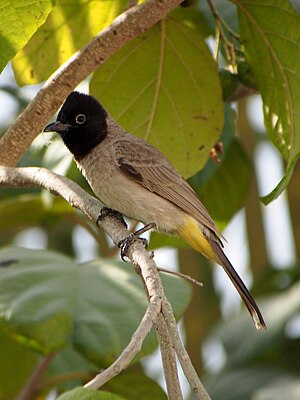Gelbsteißbülbül
| Gelbsteißbülbül | ||||||||||||
|---|---|---|---|---|---|---|---|---|---|---|---|---|

Gelbsteißbülbül ( Pycnonotus xanthopygos ) |
||||||||||||
| Systematics | ||||||||||||
|
||||||||||||
| Scientific name | ||||||||||||
| Pycnonotus xanthopygos | ||||||||||||
| ( Hemprich & Ehrenberg , 1833) |
The Gelbsteißbülbül ( Pycnonotus xanthopygos ) or Vallombrosa-Bülbül is a songbird of the genus of the real Bülbüls ( Pycnonotus ) from the family of the Bülbüls (Pycnonotidae), which is widespread in southern Turkey and in large parts of the Middle East . No subspecies are known, the species is therefore considered to be monotypical.
Appearance
The yellow rump can easily be recognized by its yellow rump and black face mask, which clearly stands out from the gray-brown breast and coat plumage. The whitish eye ring is also characteristic. The relatively long tail feathers have a fine white border. Both sexes are similar. In young birds, the color of the head feathers is brown and the eye ring is not yet so clearly pronounced. With a length of 19 centimeters, the birds are roughly the size of a thrush .
distribution
The distribution area of the Gelbsteißbülbüls is in the Middle East and includes the southern Mediterranean coast of Turkey, western Syria , Lebanon , Israel , western Jordan and the Sinai Peninsula . The species can also be found in western and central Iraq as well as in western Saudi Arabia , the United Arab Emirates , Yemen and northern and southwestern Oman .
The Gelbsteißbülbül is a common bird in large parts of its distribution area. He likes to stay in palm groves, gardens and parks or plantations with bushes and low trees. Sometimes the Gelbsteißbülbül can also be found in wadis with vegetation.
Studies in the coastal regions of Anatolia have shown that an area expansion has taken place in the west of the distribution area to the village of Gelemiş (near the ancient city of Patara ). The same study also found that outside of the breeding season, the species can also be found at higher altitudes up to 1260 meters. With the beginning of winter, the birds move back to lower elevations on the coast in the course of seasonal migrations.
nutrition
The yellow-bellied bulb feeds omnivorously on small invertebrates and insects as well as on fruits and other vegetable food such as seeds, flowers or young buds. According to a study in the Antalya region , the composition of the food changes with the seasons. While vegetables, seeds and winter fruits were consumed in the winter months from January to March, the diet consisted almost exclusively of animal nutrients between March and May. In the months that followed, up to August, both plant and animal nutrients were consumed. Then the proportion of phytonutrients in the diet increased again. The increase in animal nutrients in food consumption coincides with the start of the breeding season between March and August. The insects are mostly caught in flight, the hunting method is similar to that of the bee-eater .
Systematics
The type white-spectacled bulbul forms a collective species with the Bulbul ( P. barbatus ), the Maskenbülbül ( Pycnonotus nigricans ), the in South Africa spread Kapbülbül ( P. capensis ), Weißohrbülbül ( P. leucotis ) and in northern India and Nepal -based Himalajabülbül ( P. leucogenys ). In the past, the Gelbsteißbülbül was considered con-specific with the Graubülbül ( Pycnonotus barbatus ) found in Africa . However, no hybrids of the two species are known. The distribution areas do not overlap either.
Individual evidence
- ^ A b Mark Beaman et al .: The Handbook of Bird Identification: For Europe and the Western Palearctic. Bloomsbury, London 1998, p. 591.
- ^ A b P. Clement, E. de Juana: White-eyed Bulbul (Pycnonotus xanthopygos). In: J. del Hoyo, A. Elliott, J. Sargatal, DA Christie, E. de Juana, E. (eds.) Handbook of the Birds of the World Alive. Lynx Edicions, Barcelona 2014.
- ^ Aziz Aslan, Ali Erdogan: On the distribution of the White-spectacled Bulbul, Pycnonotus xanthopygos (Hemprich & Ehrenberg, 1833), in Turkey. Zoology in the Middle East. 41, 2007, pp. 31-34.
- ↑ Aziz Aslan et al .: Preliminary study on feeding ecology and heavy metal accumulation of White-spectacled Bulbul (Pycnonotus xanthopygos), Antalya - Turkey. In: Fresenius Environmental Bulletin. Vol. 15, No. 9b, 2006, pp. 1174-1181.
Web links
- Pycnonotus xanthopygos inthe IUCN Red List of Threatened Species 2015.1. Listed by: BirdLife International, 2012. Retrieved June 5, 2015.
- BirdLife International: Species Factsheet - White-spectacled bulbul ( Pycnonotus xanthopygos ) . Retrieved June 5, 2015.
- Videos, photos and sound recordings of White-spectacled bulbul (Pycnonotus xanthopygos) in the Internet Bird Collection
- Gelbsteißbülbül ( Pycnonotus xanthopygos ) at Avibase; Retrieved June 5, 2015.
- Pycnonotus xanthopygos in the Integrated Taxonomic Information System (ITIS). Retrieved June 5, 2015.
- xeno-canto: Sound recordings - White-spectacled bulbul ( Pycnonotus xanthopygos )
- Feathers of the yellow bite
